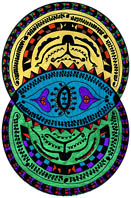A mandorla is the almond-shaped segment made when two circles overlap.  This represents the opposites experienced when we are torn by the competing demands of the rational and the intuitive mind. The mandorla reminds us that we will experience the yin and yang opposites of life: rational and intuitive, masculinity and femininity, heaven and earth, etc. When we encounter these conflicts, the mandorla suggests that we reconcile the opposites. In connecting with with the deepest level of The Intuitive Self, we learn to incorporate opposites in our personal style.
This represents the opposites experienced when we are torn by the competing demands of the rational and the intuitive mind. The mandorla reminds us that we will experience the yin and yang opposites of life: rational and intuitive, masculinity and femininity, heaven and earth, etc. When we encounter these conflicts, the mandorla suggests that we reconcile the opposites. In connecting with with the deepest level of The Intuitive Self, we learn to incorporate opposites in our personal style.
Spanning the rational and the intuitive spectrum is beyond our ordinary ways. Sometimes two irreconcilable opposites like these will drive us to distraction. It takes the integrating energy of The Intuitive Self to overlap opposites and make them whole. In our drawings, we may achieve only the tiniest sliver of a mandorla initially. But if we return often enough to the drawing, the resolution will become the permanent base of our behavior. When we truly live in both worlds, "the light" and "the dark" are no longer experienced as opposites. The mandorla examples in the Gallery visually express the wholeness of The Intuitive Self that emerges.
Synthesizing Light and Dark
Our deepening understanding of The Intuitive Self proceeds from the overlap of what we call "good" and "bad," that is the light and dark that lies within each of us. By itself the light rational side cannot connect with the deepest intuitive. However where the light and dark begin to touch, our opposites come together in the overlapping mandorla where our conflicting selves unite as The Intuitive Self.
We can view life as a mandorla where opposites find reconciliation as we connect with our essence. After a powerful mandorla experience, we return to the world of dualities, of time and space, to continue ordinary life. Acquiring the insight to live in both worlds represents the promise of The Intuitive Self that transcends the ordinary world of rational versus intuitive.
Many Selves into The Intuitive Self
From the struggle to reconcile our opposites comes a richly tapestried mandorla of many colors. We should not stop this process until our drawings contain the many "inconsistencies" in our lives. If we fail the task of reconciliation, the varied colors of life neutralize each other in a dull greyness. On the other hand when we reconnect with The Intuitive Self, the many colors of life form a magnificent pattern of "butterflies" and "rainbows" reminding us of the peacock's tail.
We should try to discover the butterflies and rainbows in our daily experience as we reach beyond mandalas into the realm of mandorlas. To the degree that we are successful with these drawings, to that degree the integration of our many selves into The Intuitive Self expresses itself in our personal style. In this way, we have the potential to become a whole person in our professional and personal lives. More effective living begins with a more effective and integrated self.
* This material was adapted from Chapter 3, The Mandorla in Robert A. Johnson, Owning Your Own Shadow: Understanding the Dark Side of the Psyche, (New York: HarperCollins Publishers, 1991), pp. 97-118.
Drawing Mandorlas
Extending the drawing process beyond mandalas to include mandorlas evokes an even deeper connection with The Intuitive Self. Drawing in two circles that overlap, the mandorla emerges as the almond shaped area where the circles intersect. This brings into focus the contrasts and apparent paradoxes we encounter in daily life. Work with the mandorla helps us resolve our conflicts to see the wholeness and integration that lies at our core beyond all duality.
Using one set each of small, medium and large felt tip markers with at least six different colors, begin filling in the two circles with whatever strokes the hands want to express. Like the mandalas, usually these movements are abstract although the examples in the Gallery show they sometimes have a concrete appearance. The drawing may extend beyond the boundaries to fill the page like the examples in this section.
As with the mandalas, we provide a mandorla template in Acrobat format. View and/or save the file to use as a drawing outline. (Please Note: In order to view and print Acrobat PDF files, you must have the freely distributed Adobe Reader installed on your computer.)
- Acrobat Mandorla Template (2K Acrobat pdf)
Observations and Comments
We have provided a few observations and comments expressed by others who have drawn mandorlas as a continuation of their mandala drawings. Their comments should inspire our work with mandorlas.